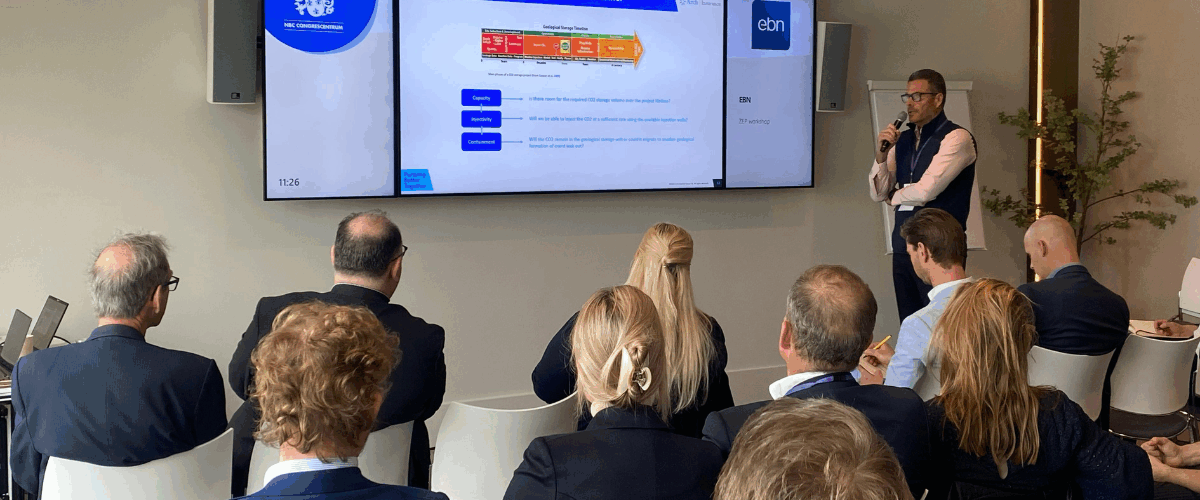De-risking CCS projects: the role of insurance
On 10 April 2025 in Nieuwegein (Utrecht, the Netherlands), the Zero Emissions Platform (ZEP) and EBN convened over 150 experts from industry, research, the insurance and financial sectors, civil society and public authorities. The goal of the workshop was to discuss practical approaches to risk allocation, de-risking investment, and the development of insurance solutions to enable large-scale CCS deployment. This article summarises the key learnings from this workshop.
About the workshop
The insurance of CCS projects remains a relatively underdeveloped area. With the expansion of the CCS project portfolio and the impending target set by the Net-Zero Industry Act (NZIA) to reach 50 million tonnes of CO₂ injection capacity by 2030 in Europe, insurance providers, project developers, and financial and commercial experts need to collaborate to facilitate the realisation of CCS projects and manage associated risks, particularly in the post-injection and post-closure phases.
The workshop was designed to provide project developers, transport and storage operators, policymakers, and investors with practical pathways to ensure and de‑risk CCS projects in Europe.
Opening Plenary – CCS in the Netherlands
Stijn Santen from EBN and chair of the ZEP Projects Network, shared insights from the nine CCS projects in which EBN, the Netherlands’ state energy company, is involved. He emphasised the importance of state-owned companies, subsidies, Public-Private Partnerships (PPPs), and the role of CCS hubs as catalysts for large-scale CCS deployment.
His speech highlighted three key points:
- The role of CCS Hubs in facilitating economies of scale, resulting in lowering CO2 abatement costs and improved risk allocation across multiple industrial emitters, while enabling shared transport and storage infrastructure, with the examples of Porthos and Aramis projects.
- The importance of national and EU-level policies (e.g., ICMS, NZIA) and funding mechanisms (e.g., CEF, Innovation Fund) in triggering the rapid growth of CCS projects in the EU.
- The role of Contracts for Differences (CfDs) play, particularly SDE++ (the Dutch government subsidy scheme), in financing CCS projects by ensuring stable cash flows over the years. Accordingly, reducing investment risks for CO2 capture and enabling long-term contracts with transport and storage providers.
Session 1 – CCS Project mapping, financing, and risk allocation
Peter-Paul Ekelschot from ING International and co-chair of ZEP Finance Working Group, provided an overview of CCS projects across Europe, including the five that have already reached final investment decision (FID).
He outlined the main considerations in financing those projects. Drawing on examples from the Netherlands, Denmark, the UK, and the U.S, he discussed the different types of government support mechanisms. He also assessed the benefits and challenges of each from a financial sector perspective.
He emphasised the key risks and the importance of their proper allocation to ensure projects’ bankability:
- Construction risk: Allocation is challenging, as delays (e.g., from emitters) can affect the entire value chain.
- Operational risk: Failures in any component (e.g., emitter, pipeline, or ship) can disrupt the system, underscoring the need for robust contingency planning.
- Commercial risk: Market uncertainties persist, highlighting the role of government backstops.
- Leakage risk: A critical area requiring clear responsibility allocation and monitoring frameworks.
Session 2 – The role of brokers connecting projects and insurance to de-risk CCS
Marie Reiter (Head of Global Broking Strategy, Natural Resources), and Alan McShane (Head of Risk Engineering, Natural Resources) outlined the risk frameworks for CCS projects. They presented the role of insurance brokers and risk engineering in managing and allocating risk.
They highlighted several key points:
- CCS as a transition enabler: 64% of respondents to the 2025 WTW Clean Energy Survey view CCS as the key technology to drive the energy transition within the next five years.
- Technology and risk familiarity: While many of the technologies employed are complex, they are not new. The associated risks largely fall within insurers’ standard exposures, and insurers are generally familiar and comfortable providing coverage. However, due to the structure of the value chain, some project parties are not fully aware of the risks associated with other parts of the chain, which can hinder project adoption.
- Early involvement of insurers: Insurers should be engaged at an early stage, allowing engineering and risk experts to contribute to design decisions, thereby minimizing costs and optimizing insurability later in the project.
- Contractual analysis: Careful review of contractual arrangements between counterparties is essential to ensure that any assumed liabilities can either be transferred to insurers or remain within acceptable risk appetite.
Session 3 – Advancing insurance products to support CCS
Rodney Garrard (Arch Insurance International) explained why CCS is a strategic area of interest. He shared Arch’s experience in developing specialised insurance products for CCS.
He emphasised several points:
- Project attrition rates: Around 75% of projects end at the feasibility stage, 10% after design, and 10% during construction. Unfavorable economics cited as the most common reason for cancellation.
- Insurance coverage: Existing insurance products already cover many of the risks associated with CCS projects. The market is evolving to develop specialised products for more specific risks, such as leakage from geological CO₂ storage sites.
- Early involvement of insurers: Engaging insurers early in the project is essential to ensure that design specifications align with insurance requirements.
Fireside Chat – Risk allocation, regulatory complexity, and opportunities to strengthen the CCS value chain
The fireside chat, moderated by Stijn Santen (EBN), brought together Fred Lockwood (OCEOS), Michael Schlaug (Yara Sluiskil), and Marten Slagter (EBN) to reflect on risk allocation, regulatory complexity, and opportunities to strengthen the CCS value chain.
The discussion highlighted the importance of balancing responsibilities across stakeholders, ensuring demand for decarbonized products, and fostering collaboration to make CCS commercially viable and scalable.
- Risk allocation across the value chain: Emitters benefit when their risks are reduced through insurance, which in turn helps shippers and other players. Since no single actor can absorb all risks, diversified allocation and insurance frameworks are essential.
- Business case and market demand: Although essential, subsidies alone are insufficient. Without demand, CCS costs cannot be recovered. The lack of demand for decarbonised products remains a major challenge for emitters. In turn, limited injection capacity creates bottlenecks between emitters and offtakers.
- Regulatory challenges: Regulatory uncertainty, particularly around shipping, CO₂ specifications, and “decarbonised” product definitions, makes investment riskier. Clear, consistent regulation is needed to support deployment.
Conclusions and next qteps
The workshop underlined the critical role of risk allocation and insurance frameworks in making CCS projects bankable and scalable across Europe. By highlighting experiences from financial institutions, insurers, and state-owned actors, the discussions emphasised the need for coordinated efforts across the value chain to de-risk investments, build market demand, and ensure regulatory clarity.
The workshop concluded with the following recommendations:
- Engage insurers and financiers early in CCS project design to minimise costs, strengthen contingency planning, and optimise insurability.
- Promote clear and consistent regulatory frameworks at both Member State and EU levels to reduce uncertainty and accelerate investment.
- Foster collaboration across the CCS value chain to balance risk and reward, unlock economies of scale, and expand injection capacity.
- Encourage market creation for decarbonised products, ensuring that demand-side measures complement subsidies to secure viable business models.

